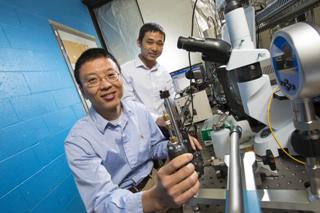Apr 7 2015
UNL engineers and the U.S. Naval Research Laboratory have designed a next-generation temperature sensor set to improve the measurement of oceanic dynamics that shape marine biology, climate patterns and military operations.
 Ming Han, an associate professor of electrical engineering at the University of Nebraska-Lincoln, and postdoctoral researcher Guigen Liu, worked with scientists at the US Naval Research Laboratory to develop a fiber-optic temperature sensor that could help learn more about ocean dynamics. Credit: Craig Chandler/University Communications/University of Nebraska-Lincoln
Ming Han, an associate professor of electrical engineering at the University of Nebraska-Lincoln, and postdoctoral researcher Guigen Liu, worked with scientists at the US Naval Research Laboratory to develop a fiber-optic temperature sensor that could help learn more about ocean dynamics. Credit: Craig Chandler/University Communications/University of Nebraska-Lincoln
The fiber-optic sensor can register significantly smaller temperature changes at roughly 30 times the speed of existing commercial counterparts, said co-designer Ming Han, associate professor of electrical engineering.
Han and postdoctoral researcher Guigen Liu achieved the results by attaching a small silicon pillar to the tip of the fused silica glass typically used in fiber optics.
The optical density of silicon naturally changes when it's exposed to even slight temperature shifts, making it a sensitive material especially suited for thermometry, according to Han. The ease with which it transfers heat, combined with the small size of the sensor, allows the silicon to register these changes at extremely fast rates.
"Silicon is really the perfect material for our applications," Han said. "We already have a lot of microprocessing technology and computer chips made from silicon -- it's been used for decades -- so it's easy to fabricate very small structures from it."
The team also developed a novel signal-processing method that averages multiple wavelength peaks to help reduce signal noise, which can introduce artificial temperature fluctuations and reduce a sensor's precision.
These qualities will prove essential to advancing the measurement of the ever-shifting and subtle temperature changes found underwater, according to Han.
"The temperature of the ocean can change rapidly and in very small amounts within a turbulent environment," Han said. "It's very difficult to measure because it requires a very high-speed sensor that can precisely detect small changes and (differentiate) a signal from noise."
Han and Liu helped meet these extreme demands by designing the sensor in collaboration with Weilin "Will" Hou, an oceanographer from the Naval Research Laboratory. The lab previously pioneered radar and GPS satellite prototypes, among many other technological breakthroughs.
"Seventy-two percent of the earth's surface is covered by water, and temperature is one of the key variables in studying the ocean," Hou said. "By introducing a sensor that is a generation ahead of everything else, we have opportunities to address some issues that previous temperature sensors could not. I would say that people are very excited about the results."
That excitement stems in part from the array of potential applications made possible by the sensor's superior performance, Hou said. He cited its potential to improve the underwater transmission of optical and acoustic signals, as well as its promise for informing the forecast of climate events.
"People who try to predict the circulation of ocean currents and the atmosphere have to know how energies mix -- in this case, the heat energy and heat flux," Hou said. "To do that, they need tools to quantify how the heat flows from one direction to another at high rates and on a small scale, which is where this work is focused.
"This has a very strong potential influence on oceanography use in general," he said. "We're confident that this collaboration will lead to a significant portfolio of new sensors."